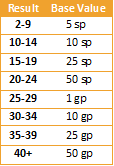 |
| Oooooh shiny! |
In the spirit of keeping the system lightweight, I limited myself to no more than three primary dice rolls. This was challenging, but I would otherwise get lost in tables of inclusions, occlusions, styles of cut, luminescence, etc. The 3-roll rule forced me to prioritize and use abstractions. I did let myself use "subrolls" - up to one level deep - to provide some additional variation. These subrolls were not allowed to consult additional tables.
An important requirement was that the system had to scale by tier, but without separate tables. So, I constructed my base gem table so that it would use Tier Dice (dT). In the current draft, that's 2d10 for Mortals, 3d10 for Heroes, and 4d10 for Demigods. Since d10's always explode in Phoenix, that also means that every so often a Mortal could get an amazing gem in their treasure - that's ok for me, as I like the drama such results can drive.
I use the silver standard in these tables, but you can change it to any suitable currency. In my rules, 1gp = 100sp.
Here is roll #1.
 |
| Base Gem Values (dT) |
 |
| Gem Statistics |
I wanted the mean to hold true, allowing GMs to come up with any sort of system they desired, so an additional objective was that rolls 2 and 3 should net out to the same mean - they should create flavor, and possibly variance, but not alter the average value of the gems.
For roll #2, I decided on weight. I've always wanted to use carats as my gem measurement in RPGs, so it was a natural choice. The values in roll #1 are the per-carat values for each gem class.
Trivia: A carat is equal to 200mg (or 0.007055 ounces for us silly Americans), and its relation to size depends on the specific gravity of the gem. Specific gravity is the density of a gem, as compared to water. A larger specific gravity means the gem is more dense. Amber has a very low specific gravity (~1), and rubies have a very high specific gravity (~4), so a 1 carat amber is quite a bit larger than a 1 carat ruby! GemSelect has a great chart of specific gravities, if you are curious about that level of descriptive detail.
 |
| Random Gem Weights (d%) |
Trivia: How realistic is this weight variance? For small gems, pretty decent. For large gems, not really - the largest diamond on Earth is 545.67 carats (the Golden Jubilee). That's technically achievable with roll #2, but with a 1d6 exploding, you'd have to roll a six 90 times in a row - and then get a 5. That will happen about once every 1071 rolls. Sort of the same odds as picking a specific random atom, given a bag containing all the atoms in the universe (give or take a galactic cluster).
Finally, roll #3. It had to be quality - and it had to not require a gemology degree to comprehend. I kept it simple.
 |
| Random Gem Quality (d%) |
All we need now are some examples of gem names for each base value class.
 |
| Gems, categorized by value-per-carat |
Using the above tables, here's 5 random gems for each tier.
Mortal Gems
1ct White Quartz, worth 5sp
0.7ct Bloodstone, worth 7sp
0.8ct uncut Blue Zircon, worth 21sp
0.7ct powdered Bone, worth 1sp
0.1ct poor Bloodstone, worth 1sp
Heroic Gems
4ct Red Coral, worth 1gp
0.8ct poor Eye Agate, worth 3sp
0.6ct Red Zircon, worth 30sp
0.2ct powdered Blue Topaz, worth 1sp
0.7ct Pyrite, worth 4sp
Demigod Gems
1ct Beryl, worth 1gp
0.9ct Purple Zircon, worth 9gp
0.9ct remarkable Bloodstone, worth 11sp
0.3ct uncut Red Zircon, worth 3sp
4ct poor Peridot, worth 88sp
This system isn't the most comprehensive random gem system ever made, but I feel that it meets my desire for variation while also having a predictable baseline.
I know this was a long post - if you made it this far, cheers!


I can't help but think if someone told me I received a 0.9ct Remarkable Bloodstone worth 11sp, a 0.9ct Purple Zircon worth 9gp and a 0.3ct uncut Red Zircon worth 3sp, all I would think is that I have 23sp in gems.
ReplyDeleteBut then I'm a gamer.
... and the merchant that bought your purple zircon for 1% of its value would laugh his ass off.
DeleteBut then I'm a gamer and a dramatist.
Incidentally, it's ok if you don't care about the description - some players do, some players don't, but I like having it there just in case.
DeleteI can see a benefit if the economy utilized the different gems, or they had some sort of impact other than flavor.
ReplyDeleteIf not, I see it the same way as goat does, without some other incentive to actually look at what the different type of gems mean or do its all just gold (or silver) to me whilst saving up to buy a new weapon or magic weapon.
An excellent point, I mean I like the flavor either way but what's the point of putting something in if it never matters?
DeleteThis gets a bit far into drafty-drafty territory but a couple of uses:
a) there is a specialty that can cut "uncut" gems to net a tidy profit... unless you screw it up
b) powdered gems can be components for crafting